Birds sing in the morning to assert their territory and attract mates. Male birds especially showcase their strength through vibrant songs, filling the air with unique melodies during the dawn chorus. This occurs mainly from March to July, peaking in May and June. Female birds also contribute, engaging in duets to strengthen social bonds. Environmental factors play a role too, affecting how far their songs can travel. There's so much more to explore about these fascinating vocalizations.
Key Takeaways
- Male birds sing in the morning to assert territory and attract mates during the breeding season.
- The dawn chorus occurs under optimal conditions, allowing songs to travel farther and be heard clearly.
- Singing is most prominent between March and July, peaking in May and June, coinciding with breeding.
- Female birds also participate in singing, often engaging in duets to strengthen social bonds with their partners.
- Environmental factors like temperature, humidity, and light influence the clarity and distance of bird songs.
The Dawn Chorus Phenomenon

As dawn breaks, you might find yourself enveloped in the enchanting sounds of the dawn chorus, a remarkable phenomenon where wild birds, primarily males, sing harmoniously just before sunrise.
From March to July, especially in May and June, you'll hear birds sing within the first 30 minutes of daylight. This is when the air is still and background noise is minimal, allowing their melodies to travel far and wide.
Each species contributes its unique tune, creating an orchestra of sound. The dawn chorus serves vital purposes—males establish territory and attract mates with their powerful songs.
The Role of Male Birds in Morning Singing
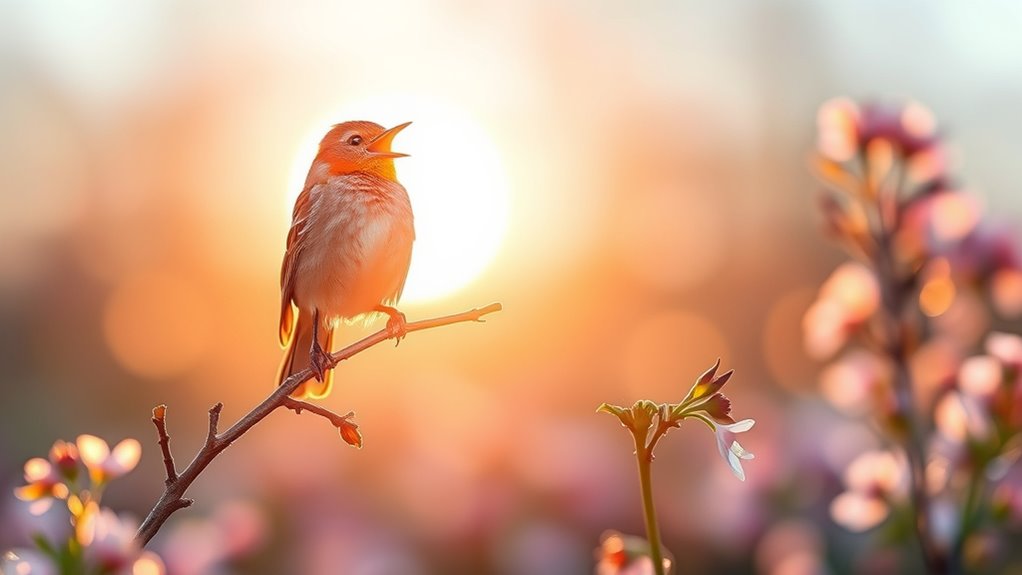
When you listen to male birds singing in the morning, you're hearing more than just beautiful melodies.
They're asserting their territory and trying to attract mates, showcasing their strength and vigor.
This morning chorus is a strategic move during the breeding season, as they compete for both space and the attention of females.
Territory Assertion
Male birds use their morning songs to assert ownership of their territory, effectively signaling to other males that encroachment won't be tolerated. These songs not only convey identity but also demonstrate fitness, essential for territory assertion. The unique characteristics of each song allow you to recognize individual singers, while the vigorous performances showcase a male's ability to defend resources.
| Feature | Description | Importance |
|---|---|---|
| Loudness | Morning songs are louder | Enhances distance of sound |
| Timing | Sung during predawn hours | Quieter environment for clarity |
| Vigorousness | Energetic performances | Displays fitness and strength |
Through this singing, males not only establish territory but also deter potential rivals.
Mate Attraction
While dawn breaks and the world stirs, the vibrant songs of male birds fill the air, enchanting potential mates.
As an early bird, you'll notice that these melodious calls serve a dual purpose: attracting females and establishing territory. A male's loud, complex song signals his health and fitness, making him more appealing to females.
During the dawn chorus, he performs his most impressive vocal displays, showcasing strength and vigor that can deter rival males. This strategic timing not only enhances his chances of securing a mate but also creates a favorable environment for females to assess male quality from a distance.
Optimal Conditions for Birdsong

What makes the early morning the perfect time for birds to sing? In these hours, cooler and drier conditions enhance sound propagation, allowing their songs to travel farther.
With reduced background noise and minimal human activity, bird songs become clearer and more effective for communication. You'll notice how birds can carry their songs up to 20 times farther in still air, maximizing their reach to potential mates and rivals.
The absence of wind during these early hours also contributes to precise sound transmission. Best singing conditions align just before and during sunrise, perfectly fitting birds' natural behaviors for establishing territory and attracting mates.
This combination makes the early morning an ideal backdrop for their enchanting dawn chorus.
Timing and Frequency of Morning Songs

You'll notice that birds start their morning songs about an hour before sunrise, taking advantage of the quiet hours.
The peak singing happens in the 30 minutes right after dawn, when conditions are just right for attracting mates and avoiding predators.
From March to July, especially in May and June, you'll hear the most vibrant melodies if you're up early enough to listen.
Optimal Singing Conditions
As dawn approaches, birds take advantage of the calm morning air and reduced noise, creating the ideal conditions for their songs. The dawn chorus typically kicks off just before sunrise, allowing birds to optimize sound transmission in cool, still environments.
During the early morning hours, their songs resonate clearly and travel farther, enhancing communication. In urban areas, artificial light can disrupt this natural rhythm, leading to earlier singing.
Notably, research shows that birds' singing abilities peak after a warm-up period, leading to the most complex performances later in the morning. Additionally, factors like cloud cover and habitat type can affect how and when birds sing, resulting in unique morning soundscapes across different locations.
Peak Singing Times
While many people enjoy the soothing sounds of birds in the morning, the peak singing times reveal a fascinating pattern.
Understanding these times enhances your appreciation of this daily symphony. Here are three key points to take into account:
- Dawn Chorus: Birds typically start singing about an hour before sunrise, with peak activity occurring shortly after.
- Breeding Season: Ideal singing times fall between March and July, peaking in May and June when many birds are attracting mates.
- Environmental Influence: Urban settings can alter peak singing times, as artificial light prompts birds to start earlier than their rural counterparts.
Territorial Claims and Mate Attraction
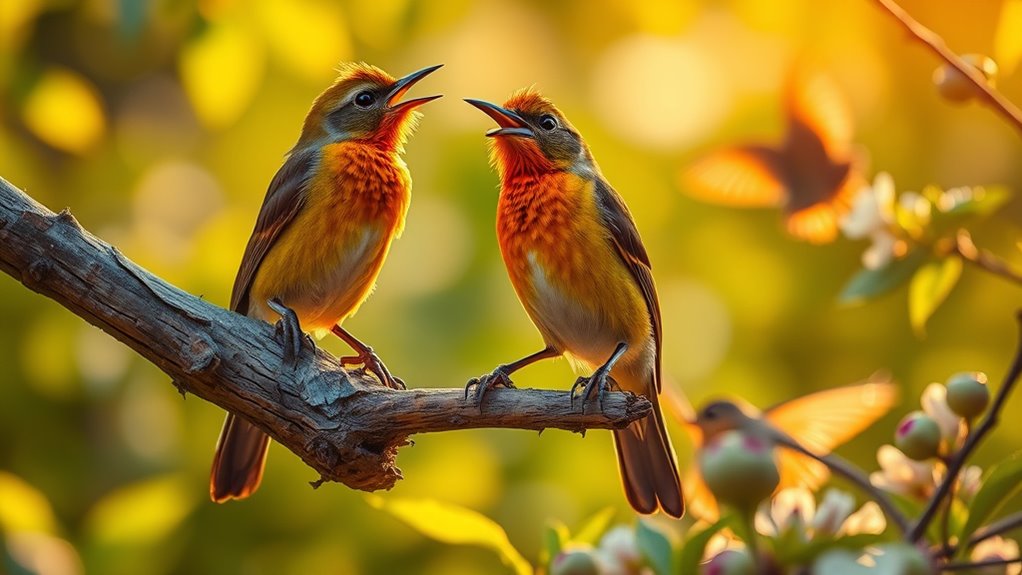
When male birds sing in the morning, they're not just filling the air with melodies; they're making powerful statements about their territory and fitness. Their birds song serves as a bold declaration, deterring rival males from encroaching on their space.
Those loud, complex tunes during the dawn chorus signal to potential mates that the singer is strong and healthy. By singing at dawn, birds maximize their visibility to females, as the calm morning enhances sound transmission and reduces background noise.
Research shows that a strong singing performance greatly boosts a male bird's chances of attracting a mate. Ultimately, territorial singing not only communicates resource availability but also establishes and maintains breeding territories essential for reproductive success.
Unique Characteristics of Bird Songs
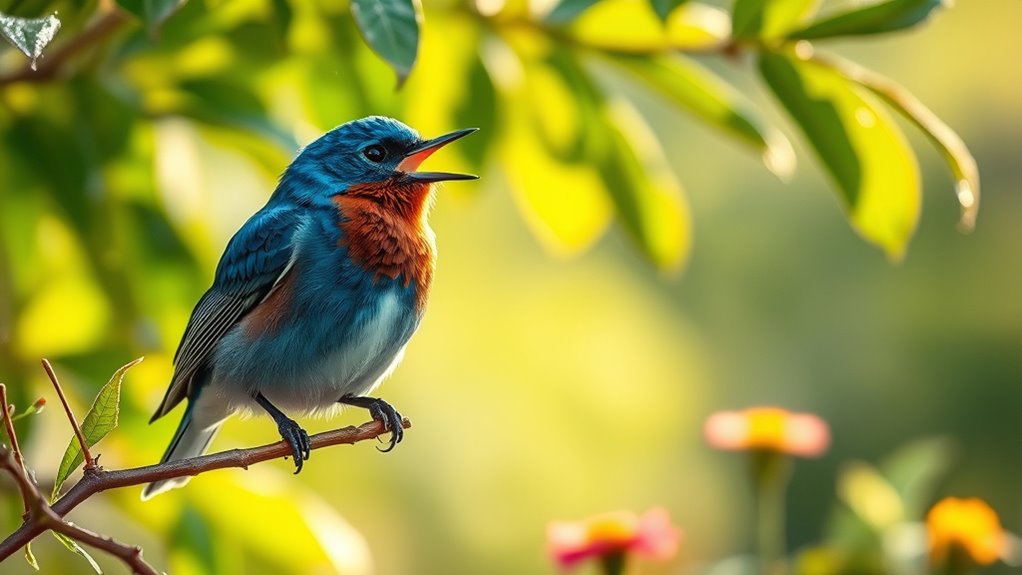
When you listen to birds in the morning, notice how each species has its own unique song variations.
The complexity and length of these songs can reveal a bird's health and energy, while dueting behaviors between pairs highlight their cooperative nature.
Understanding these characteristics can deepen your appreciation for the intricate world of bird communication.
Individual Song Variations
Many birds exhibit remarkable individual song variations that reflect their unique characteristics and significance. These variations not only serve to communicate but also play an important role in attracting mates.
Here are three key aspects of individual bird songs:
- Distinct Patterns: Each species has unique trills and melodies that help you identify them early in the morning.
- Song Complexity: More intricate songs often reveal higher energy levels, indicating the singer's health and liveliness.
- Female Performances: In some species, females sing longer, showcasing their quality and fitness, which can be as enchanting as the male's song.
These unique song traits are essential for avian communication and mate selection, making them a significant aspect of their lives.
Complexity and Length
While observing birds in the morning, you might notice that the complexity and length of their songs reveal much about their liveliness and appeal.
Longer, more intricate songs often indicate a bird's energy levels and overall fitness, suggesting that healthier individuals can produce more complex melodies.
Curiously, female birds typically sing these elaborate songs more frequently than males, making them more attractive to potential mates.
The physical traits of each bird, like size and vocal apparatus, also play a role in the richness of their songs.
Each unique song allows birds to establish their territory and communicate effectively, showcasing their individual qualities while enhancing their chances of attracting a partner.
Dueting Behaviors
Bird songs go beyond individual expression, revealing fascinating social dynamics through behaviors like dueting. When you observe bonded bird pairs singing together, you witness a unique form of communication that reinforces their bond.
Here are three key aspects of dueting behaviors:
- Social Bonding: Dueting helps strengthen the connection between partners, ensuring they remain synchronized in their activities.
- Coordination: Birds often use duets to signal food requests or other cooperative tasks, enhancing their teamwork.
- Territory Defense: Synchronized songs can deter intruders, marking their territory and showcasing their unity.
Interestingly, research now highlights female participation in dueting, challenging the traditional notion that only males dominate bird songs.
This behavior reflects complex social structures in the avian world, showcasing their remarkable communication skills.
Environmental Influences on Singing Behavior
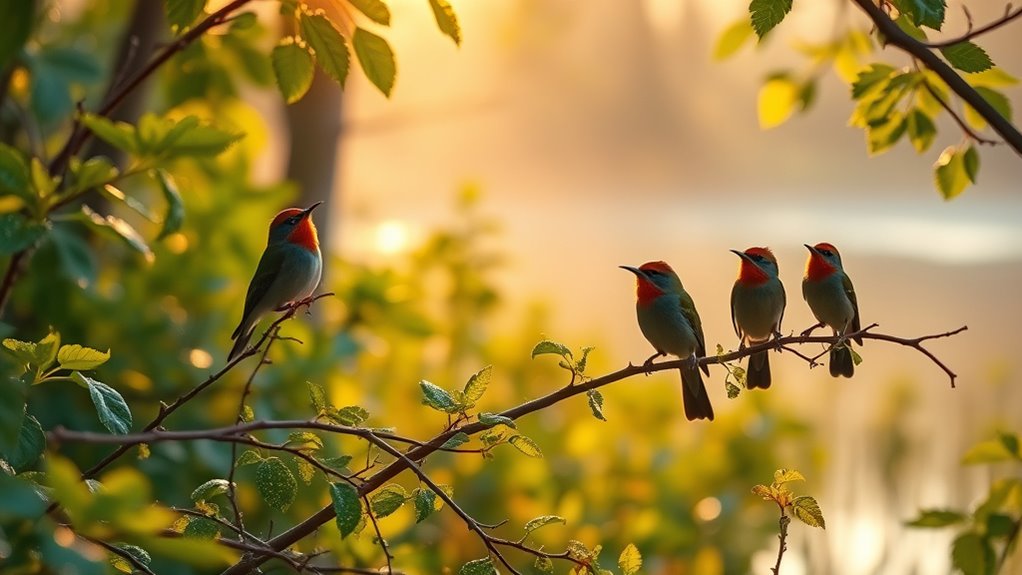
As dawn approaches, various environmental factors influence how and when birds sing, creating a dynamic soundscape. The dawn chorus often kicks off just before sunrise, utilizing ideal light for visibility and communication among birds.
In urban areas, artificial lighting causes an earlier start to this chorus, disrupting natural circadian rhythms. Additionally, cloud cover can enhance sound propagation, making bird songs clearer and more prominent.
Temperature and humidity also play key roles, as cool, still air allows songs to travel farther.
Finally, local habitats affect singing patterns; dense vegetation or urbanization can lead to significant differences in timing and frequency, resulting in unique chorus patterns across different environments.
Research Insights on Bird Vocalization

Understanding how environmental factors shape singing behavior sets the stage for exploring the latest research on bird vocalization. Studies, particularly from Duke University, reveal fascinating insights about when and how birds sing:
- Time of Day: Swamp sparrows improve their singing throughout the day, with performance peaking after morning warm-ups.
- Dawn Chorus: Male birds typically dominate the early morning, using the quieter atmosphere to attract mates and establish territories.
- Environmental Impact: Factors like urban lighting and cloud cover can shift singing times, causing urban birds to start their choruses earlier than their rural counterparts.
These findings highlight the intricate relationship between time and vocal performance, showcasing how birds adapt their singing habits to their surroundings.
Notable Singing Species and Their Behaviors
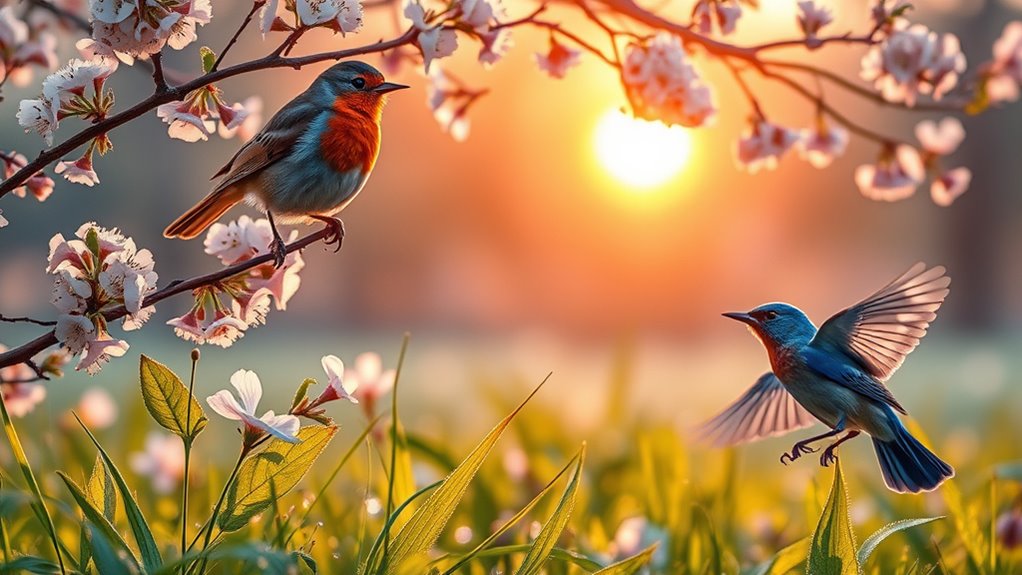
While many might associate singing primarily with male birds, numerous species showcase remarkable vocal talents among females as well. Female birds like eastern phoebes and purple martins contribute to territorial defense and communication, proving that their voices matter in the avian world. Additionally, studies suggest that mental clarity can be positively influenced by the calming effects of bird songs, enhancing overall well-being.
| Species | Female Singing Behavior | Purpose |
|---|---|---|
| Eastern Towhee | Songs during mating season | Attracts mates |
| Black-capped Chickadee | Engages in song for territory defense | Communication with others |
| Song Sparrow | Melodious songs to deter rivals | Attracts females and establishes territory |
These examples highlight the diverse and essential roles female birds play in vocalization, enhancing your understanding of avian communication dynamics.
Engaging With Nature: Listening to the Dawn Chorus

Birdwatching takes on a new dimension during the dawn chorus, when the morning air fills with a symphony of birdsong.
From March to July, especially in May and June, you can witness this delightful spectacle.
To fully engage with nature, here are three tips:
- Listen around sunrise: Aim for about 30 minutes after the sun rises, when the chorus is most vibrant.
- Find a quiet spot: Early mornings provide still air, enhancing sounds that carry up to 20 times farther.
- Identify species: Notice how robins, blackbirds, and thrushes lead the chorus, followed by others like woodpigeons and warblers.
Experiencing the dawn chorus fosters a deeper appreciation for the complex communication of birds.
Frequently Asked Questions
Why Are Birds so Vocal in the Morning?
You might notice that birds are especially vocal in the morning, and it's fascinating. They sing to attract mates and establish their territory.
The calmness of the early hours allows their songs to travel further, reaching potential partners or warning rivals. You'll hear a mix of males and some females joining in, creating a lively morning chorus.
As the day progresses, their vocal performances tend to become more complex and longer.
Why Were the Birds so Loud This Morning?
Imagine stepping outside at dawn, like flipping on a live concert stream.
You've noticed the birds were particularly loud this morning, right? This could be due to the calm, cool air that lets their songs travel farther.
With fewer predators around and less environmental noise, their calls ring clearer, making it easier for them to establish territory and attract mates.
It's all part of nature's vibrant morning show!
What Are Birds Saying When They Sing?
When birds sing, they're conveying important messages. You might hear them asserting territory, warning other birds to stay away.
Their unique songs help you identify different species, as each bird has its own distinct melody. Males often sing to attract females, showcasing their health and fitness through the complexity of their tunes.
Even females join in, using their voices for communication and to challenge male competitors, creating a vibrant avian conversation.
What Birds Sing in the Morning?
In the early hours, you'll hear a delightful mix of birds singing. Robins and blackbirds often kick off the dawn chorus, followed by thrushes.
As the sun rises, woodpigeons, wrens, and warblers join in, creating a beautiful soundscape.
Once it gets brighter, great tits, blue tits, sparrows, and finches add their voices to the symphony. Each species brings its own unique melody, making morning a magical time for birdwatching.
Conclusion
To summarize, the dawn chorus is a enchanting symphony of nature, revealing how birdsong intertwines with their survival and social dynamics. As you listen to these feathered maestros serenade the morning, you're not just hearing their calls; you're witnessing a timeless ritual as old as time itself. So, next time you awake to their melodies, take a moment to appreciate this mesmerizing spectacle—it's nature's way of reminding us of the beauty and complexity of life.










